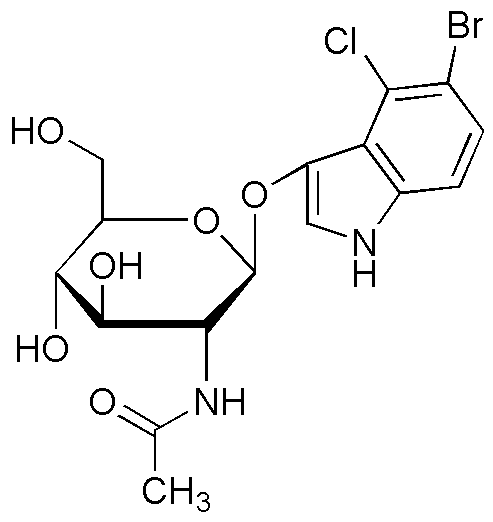5-Bromo-4-chloro-3-indolyl-N-acetyl-b-D-glucosaminide is widely utilized in research focused on:
- Biotechnology: This compound serves as a substrate in enzymatic assays, particularly for studying glycosyltransferases, which are crucial in the development of biopharmaceuticals.
- Pharmaceutical Development: It is used in drug discovery processes, especially for screening potential inhibitors of specific enzymes, aiding in the identification of new therapeutic agents.
- Diagnostic Applications: The compound can be employed in the development of diagnostic tests, particularly in detecting bacterial infections by targeting specific glycosylation patterns.
- Research in Cancer Biology: It has applications in cancer research, where it helps in understanding the role of glycosylation in tumor progression and metastasis.
- Food Industry: This chemical is also explored for its potential use in food safety testing, particularly in detecting glycosylated toxins or pathogens.
General Information
Properties
Safety and Regulations
Applications
5-Bromo-4-chloro-3-indolyl-N-acetyl-b-D-glucosaminide is widely utilized in research focused on:
- Biotechnology: This compound serves as a substrate in enzymatic assays, particularly for studying glycosyltransferases, which are crucial in the development of biopharmaceuticals.
- Pharmaceutical Development: It is used in drug discovery processes, especially for screening potential inhibitors of specific enzymes, aiding in the identification of new therapeutic agents.
- Diagnostic Applications: The compound can be employed in the development of diagnostic tests, particularly in detecting bacterial infections by targeting specific glycosylation patterns.
- Research in Cancer Biology: It has applications in cancer research, where it helps in understanding the role of glycosylation in tumor progression and metastasis.
- Food Industry: This chemical is also explored for its potential use in food safety testing, particularly in detecting glycosylated toxins or pathogens.
Documents
Safety Data Sheets (SDS)
The SDS provides comprehensive safety information on handling, storage, and disposal of the product.
Product Specification (PS)
The PS provides a comprehensive breakdown of the product’s properties, including chemical composition, physical state, purity, and storage requirements. It also details acceptable quality ranges and the product's intended applications.
Certificates of Analysis (COA)
Search for Certificates of Analysis (COA) by entering the products Lot Number. Lot and Batch Numbers can be found on a product’s label following the words ‘Lot’ or ‘Batch’.
*Catalog Number
*Lot Number
Certificates Of Origin (COO)
This COO confirms the country where the product was manufactured, and also details the materials and components used in it and whether it is derived from natural, synthetic, or other specific sources. This certificate may be required for customs, trade, and regulatory compliance.
*Catalog Number
*Lot Number
Safety Data Sheets (SDS)
The SDS provides comprehensive safety information on handling, storage, and disposal of the product.
DownloadProduct Specification (PS)
The PS provides a comprehensive breakdown of the product’s properties, including chemical composition, physical state, purity, and storage requirements. It also details acceptable quality ranges and the product's intended applications.
DownloadCertificates of Analysis (COA)
Search for Certificates of Analysis (COA) by entering the products Lot Number. Lot and Batch Numbers can be found on a product’s label following the words ‘Lot’ or ‘Batch’.
*Catalog Number
*Lot Number
Certificates Of Origin (COO)
This COO confirms the country where the product was manufactured, and also details the materials and components used in it and whether it is derived from natural, synthetic, or other specific sources. This certificate may be required for customs, trade, and regulatory compliance.


